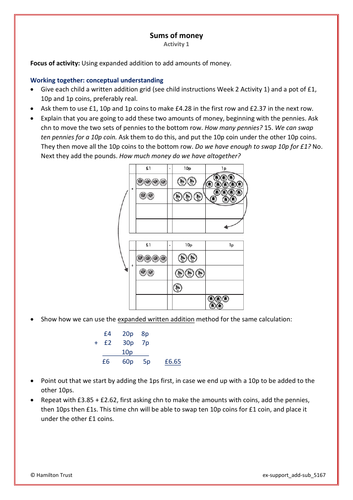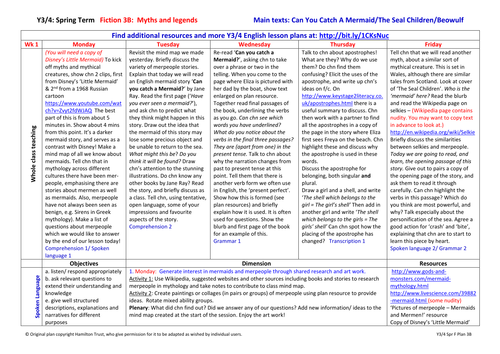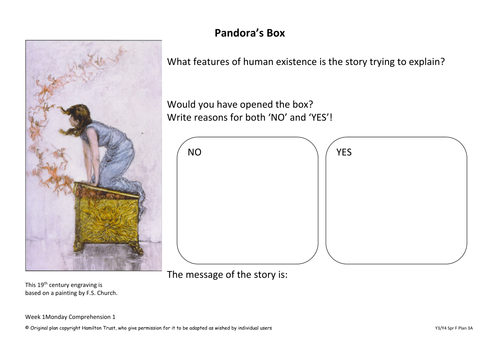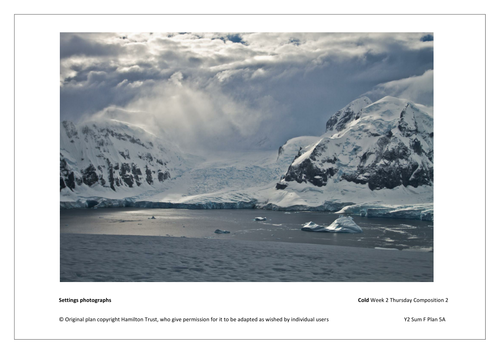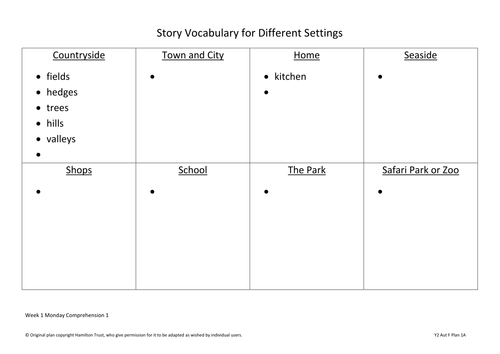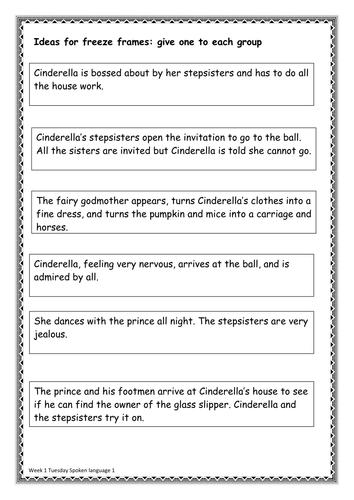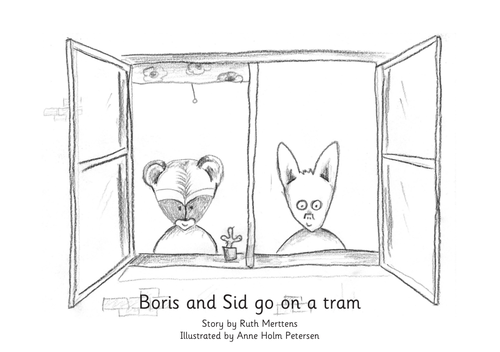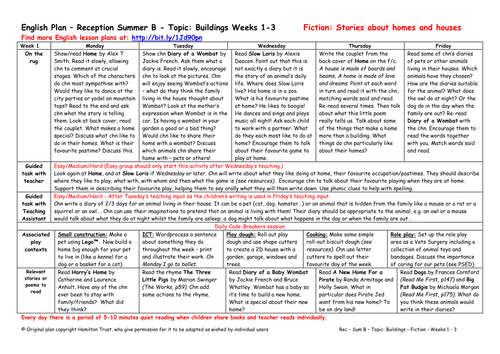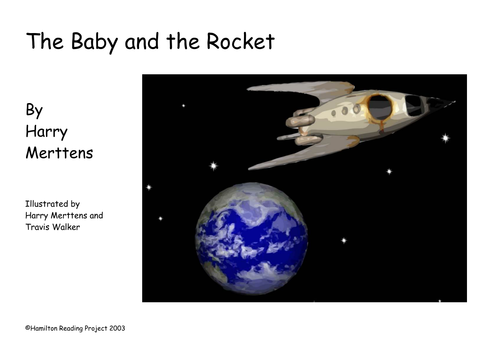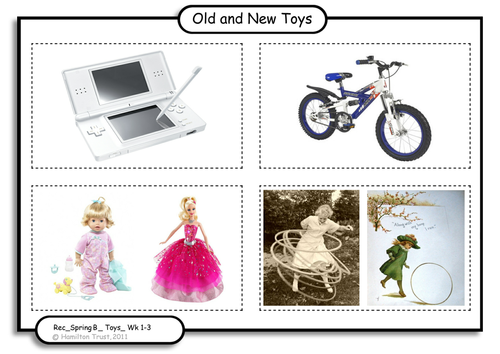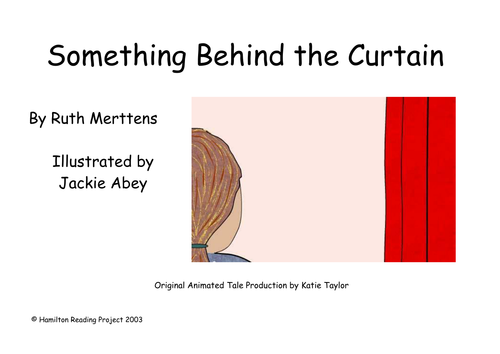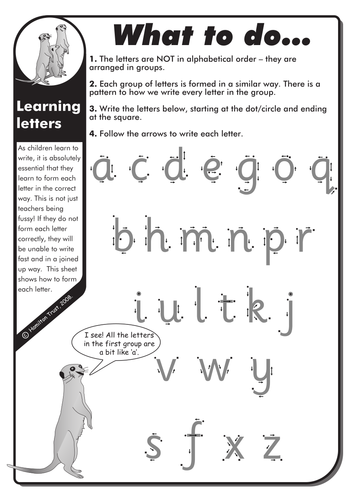
397Uploads
10060k+Views
11655k+Downloads
All resources

Extra Support Activity: Decimal and money calculation. (Year 5 Addition and Subtraction)
This activity is designed to be used by a teacher or a TA with children who need extra support before they can tackle these National Curriculum objectives: Decimal and money calculation.
Sums of Money - Using expanded addition to add amounts of money
DVD Decisions - Using counting up (Frog) to calculate change from £10
This Extra Support Activity is part of our Year 5 Addition and Subtraction block. Each Hamilton maths block contains a complete set of planning and resources to teach a terms worth of objectives for one of the National Curriculum for England’s maths areas.

Problem-Solving Investigation: Decimal and money calculation. (Year 5 Addition and Subtraction)
Year 5 Addition and Subtraction: Decimal and money calculation.
This in-depth Maths Investigation will develop maths meta-skills, and enable children to learn to think mathematically and articulate mathematical ideas.
In-depth Investigation: Adding Odd and Even Amounts
Children create two amounts of money – one with even digits, one with odd digits – and add these. They look for patterns of even/odd in the totals.
This problem-solving investigation is part of our Year 5 Addition and Subtraction block. Each Hamilton maths block contains a complete set of planning and resources to teach a terms worth of objectives for one of the National Curriculum for England’s maths areas.

Animals including Humans - Healthy Animals - Year 2
Hatch eggs and study the life cycle of chickens. Build understanding that exercise makes the heart work harder and that it is an essential part of a healthy lifestyle. Find out about healthy lunch box foods before designing and sharing your own snack.
Includes 6 session plans & resources
01 - Hatching eggs!
02 - Babies!
03- Stranded!
04 - Healthy hearts!
05 - Deep inside my lunch box!
06 - Pack a healthy picnic!
Hamilton’s science scheme provides children with a broad but comprehensive experience of primary science that systematically covers all of the National Curriculum for England objectives. Each year group is split into 6 blocks of 6 sessions, each of which can be completed within a half-term. We present them in a recommended teaching order, but you may adapt this to fit your requirements. Working scientifically, investigations and meaningful outcomes are fully incorporated in each block.

Year 3/4 Fiction 3: Myths and Legends
Children explore a variety of myths and enjoy the mythical creatures introduced in Can You Catch A Mermaid?, The Seal Children and Beowulf.
They learn these tales and use them as stimuli for creating their own myths and legends. They use the texts as models to help develop their understanding of detailed description in writing and correct grammar.
Suitable for Year 3 and 4.

Year 3/4 Fiction 5: Adventure stories
Using The Hodgeheg by Dick King-Smith, children look for examples of adverbs and adverbial phrases. They memorise a section of dialogue and use it as a basis for their own writing. In the second week the focus is on complex and compound sentences as children write an animal adventure story.

Year 3/4 Fiction 3: Myths and legends
Become familiar with a range of Greek Myths, The Orchard Book of Greek Myths by Geraldine McCraughrean, Greek Myths by Marcia Williams. Use them to study powerful verbs, verb tenses, use of first and third person, paragraphs and ways of showing dialogue. Children draw story maps to learn a Greek Myth off by heart and to retell another myth in written form.

Year 3 Fiction 1: Stories by the same author (Michael Foreman)
Using the delightful illustrations and books of Michael Foreman (Dinosaurs and All That Rubbish and I'll Take You to Mrs Cole), children have many opportunities to practice simple, compound and complex sentences with powerful verbs. They then create their own stories based around I'll Take You to Mrs Cole, by Nigel Gray and Michael Foreman.

Year 2 Fiction 5: Quest stories
Children read a range of quest stories, exploring structure and language choice. They explore 4 types of sentence and experiment with tense. Children write their own extended stories, concluding by performing their writing to a younger child. This plan uses the books Lost and Found and The Way Back Home, both by Oliver Jeffers and We're Going on a Bear Hunt by Michael Rosen. It also uses Hamilton Group Reader The Quest.

Year 2 Fiction 3: Traditional tales from other cultures
Read and compare Hansel and Gretel by Anthony Browne, and Baba Yaga and the Stolen Baby by Alison Lurie, Francis Lincoln, and Baba Yaga by Tony Bradman using drama and story maps. Discuss joining sentences using or, and or but. Children write witch stories using story pegs to plan. Introduce some 'story language' and encourage interesting endings. Hamilton Group Reader, Why Not Me?, is used to build confidence in reading aloud.

Year 2 Fiction 1: Stories in familiar settings
Explore familiar settings through Margaret Mahy's story A Lion in the Meadow, You Choose by Nick Sharratt and There’s No Such Thing as a Dragon by Jack Kent. Children generate ideas and plan a story about an animal that lives in their house under the stairs. There is a focus on using simple punctuation and story problems and solutions.

Year 1 Fiction 5: Fairy stories
Use three traditional tales to study characters and settings, sequence events, tell oral stories and plan new versions of old favourites. Use story maps to retell tales. Children write a story based on a traditional tale using adjectives and compound sentences. The plan uses Snow White in New York by Fiona French. Hamilton Group Reader Billy Dogs Gruff is used to build confidence in reading aloud.

Year 1 Fiction 3: Stories with repeating patterns and counting stories
Read a story with repeating patterns, Bringing the Rain to Kapiti Plain, by Verna Aardema. Retell the story using flow charts, write describing words and punctuate sentences. Read two counting stories Handa’s Hen by Eileen Browne and We All Went on Safari by Laurie Krebs, before guiding children to write their own. The Hamilton Group Reader, Boris and Sid go on a tram, is used to develop confidence in reading aloud.

Reception Fiction (Buildings): Stories about homes and houses (weeks 1-3)
Listen to stories about different homes for people and creatures and decide where they would like to live, Home by Alex T Smith, The Town Mouse and the Country Mouse by Helen Ward, and Diary of a Wombat by Jackie French and Bruce Whatley. Children write their own version of The Town and Country Mouse and use The Lighthouse Keeper’s Lunch by Ronda and David Armitage to plan best lunches. Keep diaries, make lighthouses and stormy music.

Reception Non-fiction (Space): Information and instructions (weeks 1-2)
Use the Animated Tale The Baby and the Rocket to introduce children to information texts. Compare facts and fiction. Make a large rocket and use photos of the construction to write instructions. Lots of activities for children to investigate both planets and rockets.

Reception Non-fiction (Toys): Labels, captions, list, descriptions (weeks 1-3)
Taking inspiration from I Love You Blue Kangaroo by Emma Chichester-Clark, children share favourite toys and write descriptions. They talk about toys from long ago with a visitor, learn about old bears and make a class toy museum of old and new toys writing factual statements for displays.

Reception Non-fiction (Dinosaurs): Information texts (weeks 1-2)
Use a 'dinosaur egg' to stimulate discussion about eggs and dinosaurs. Have fun with a range of activities, count and sound out words (Harry and the Bucketful of Dinosaurs by Ian Whybrow and Adrian Reynolds, How do Dinosaurs Get Well Soon by Jane Yolen and Mark Teague), pelmanism, Top Trumps and Dinosaur Dash. Make various dinosaur-related objects, 'steal' dino eggs and draw and label dinosaurs.

Reception Non-fiction (Families): Names, captions and notices (weeks 1-2)
Discuss families and the various roles within them, read the following stories My Mum, My Dad, Me and You, all of which are by Anthony Browne and Don’t Let the Pigeon Drive the Bus and Don’t Let the Pigeon Stay Up Late by Mo Willems. Children write a book about someone who cares for them using similes and also notices for family members. They learn their address too. Activities include paper people, house plans, family portraits and names.

Year 1 - Fiction 1: Stories with familiar settings
Use the story of Knuffle Bunny, by Mo Willems, to inspire children to write a story about their favourite soft toy. Practise forming upper and lower case letters. Use capital letters for names and to start sentences. Investigate words ending in 'le' and words containing /oy/.

London's Olympic Legacy
The Olympics is now the largest sporting event on Earth, but that was not always the case. Children compare today with its early London incarnations and investigate what happened to the facilities after the torch was extinguished!

London Olympics 1908 and 1948
2012 brings with it London’s third Summer Olympic Games! In this session children find out more about the games in 1908 and those in 1948. Through research of the past they discover what made them unique in so many ways.

